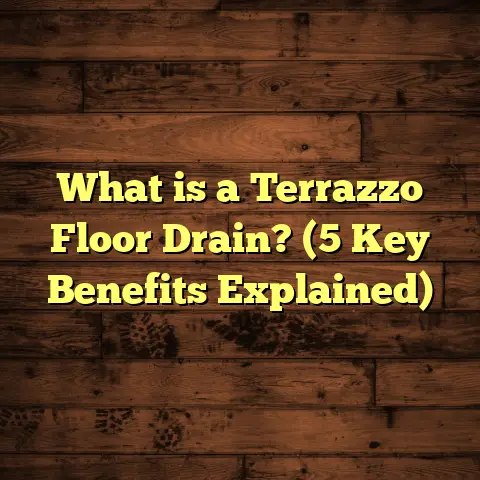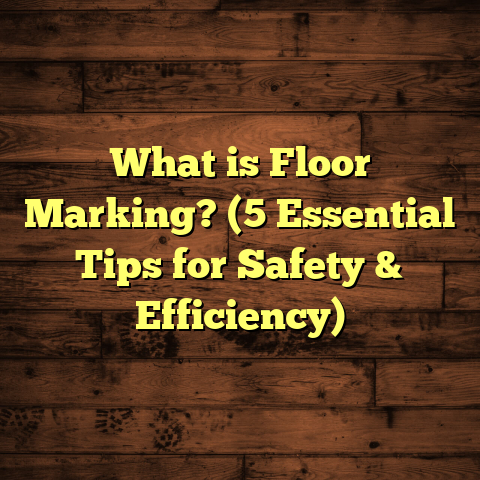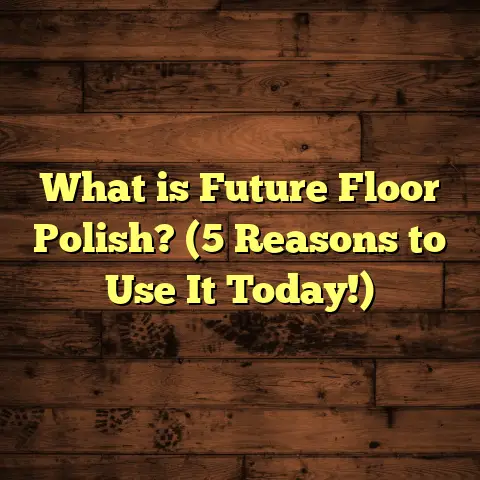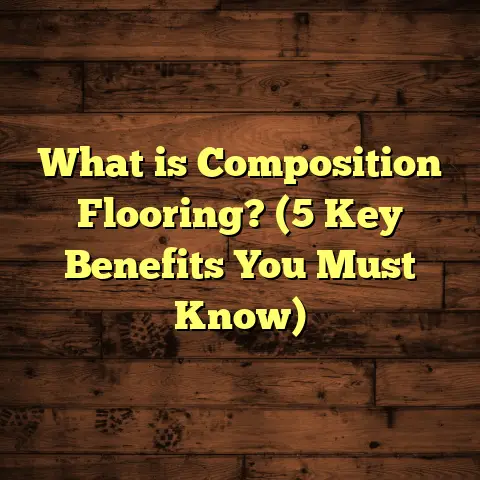What is LVT Strip Flooring? (5 Advantages You Didn’t Know)
Sustainability has become a key factor for me whenever I pick materials for
home projects. It’s not just about how things look or cost anymore—it’s about
making choices that are kinder to the planet while still fitting my style and
practical needs. One flooring option that really caught my attention recently is
LVT strip flooring.
I’ve spent quite some time learning about it, installing it in different spaces,
and seeing how it performs firsthand. Today, I want to share what I’ve learned,
adding some personal stories and fresh insights that might surprise you.
So, let’s start with the basics.
What Is LVT Strip Flooring?
LVT stands for Luxury Vinyl Tile, and the “strip” part refers to the shape and size
of each piece. These strips are long and narrow, kind of like hardwood planks,
which makes them really versatile when it comes to laying patterns and room design.
Unlike traditional vinyl sheet flooring, which comes in large rolls or sheets, LVT
is made up of individual strips or tiles you can mix and match. This means you get
the look of natural materials—wood, stone, even ceramic—with the benefits of vinyl.
The construction of LVT strip flooring is layered:
- Wear Layer: The top layer protects against scratches, scuffs, and stains. This is
what keeps your floor looking fresh for years. Thickness here can vary — usually
from 6 mil (commercial-grade) to 20 mil or more for heavy residential use. - Design Layer: This is the printed layer underneath the wear layer that gives the
floor its realistic look—wood grain, stone textures, or other patterns. Advanced
printing techniques make this surprisingly authentic. - Core Layer: The heart of the plank, providing stability and durability. This can be
flexible vinyl or rigid core material depending on the product line. - Backing Layer: Some LVT strips come with an attached underlayment for comfort
and noise reduction.
I remember installing LVT strip flooring in my own living room a few years ago. I was
looking for something warm and inviting but practical enough for everyday life with
kids and pets. The wood-look strips gave me that cozy feel without the worry about
scratches or water damage that real hardwood would bring.
Why Should You Care About This Construction?
It’s because the layers work together to create a floor that’s durable yet flexible enough
to handle temperature changes and foot traffic without cracking or buckling.
Quick Stats:
- The Luxury Vinyl Tile market grew by over 8% annually worldwide from 2018 to 2023.
- Residential-grade LVT wear layers typically range from 12 mil to 20 mil thick; commercial
floors have thinner wear layers but tougher cores. - Average cost ranges between $2 to $7 per square foot depending on quality and design complexity.
Now that you know what LVT strip flooring is, let me tell you about five advantages of this material that many people don’t realize.
1. Sustainability Wins You Didn’t Expect
When most people think of vinyl flooring, they picture synthetic plastic materials that aren’t eco-friendly. I used to think that too. But manufacturers have changed a lot in recent years.
Recycled Content: Many LVT brands now include recycled vinyl or other recycled materials in their products. Some even use recycled wood fibers or stone dust in their composite cores.
Low VOC Emissions: VOCs are volatile organic compounds that can pollute indoor air quality and cause health issues. Modern LVT products often carry certifications like FloorScore® or GREENGUARD Gold, ensuring low VOC emissions for healthier homes.
During one renovation project in my neighborhood, I chose an LVT line certified by FloorScore®. The homeowner was thrilled knowing their new floors wouldn’t affect the indoor air quality, especially since they had young children with asthma.
Longevity Means Less Waste: Because LVT is tough and long-lasting, you don’t need to replace it as often as cheaper vinyl options or laminate floors that might warp or chip over time. This durability reduces landfill waste in the long run.
Recyclability: In some regions, you can recycle old LVT flooring after removal rather than tossing it out.
Interesting Data Point:
According to a 2023 report by the Vinyl Institute, about 25% of vinyl flooring sold in North America now contains recycled content, up from less than 10% a decade ago.
This shift indicates a growing commitment to sustainability within the industry.
2. Comfort Underfoot That Surprised Me
I didn’t expect vinyl flooring to feel comfortable until I tried LVT strips with cushion backing.
Compared to ceramic tile or hardwood—which can feel cold and hard on your feet—LVT offers a softer surface to walk on.
If you spend lots of time standing in your kitchen or have kids who play on the floor, this makes a big difference.
One client I worked with had an older home with cold stone floors in the kitchen. After installing cushioned LVT strips, she told me she no longer wore slippers all day long!
The cushioning also helps reduce foot fatigue and adds sound absorption—great if you live in an apartment or multi-level house.
Slip Resistance
Many LVT products come with textured surfaces that improve traction, lowering the risk of slips and falls—especially useful for families with small children or elderly members.
3. Water Resistance That Works Like a Charm
If you’ve ever had hardwood floors swell or laminate warp due to water spills or humidity, you know how frustrating water damage can be.
LVT strip flooring handles moisture far better than wood-based floors.
I installed LVT in a bathroom renovation last year, and it was amazing to see how easy it was to clean up water splashes without worrying about warping or mold growth.
This makes LVT an excellent option for kitchens, bathrooms, basements, mudrooms—even commercial spaces like cafes where spills happen regularly.
Advanced Waterproof Options
Some newer LVT products feature rigid cores and waterproof locking systems that make them fully waterproof—not just water-resistant.
These rigid-core LVT floors can be installed in places no other vinyl could go before—including laundry rooms or even below-grade basements prone to occasional flooding.
4. Design Flexibility That Feels Unlimited
One of the biggest surprises for me was how realistic and beautiful LVT strip flooring looks nowadays.
Gone are the days when vinyl was instantly recognizable as “fake.” Now it’s hard to tell these planks apart from real hardwood or stone at a glance—or even when you touch them.
The printed layers use high-definition digital printing technology plus embossed textures that replicate natural grains and stone details perfectly.
I once worked on a project where my client wanted a unique herringbone pattern using multiple wood tones of LVT strips.
We experimented with mixing colors and finishes until we created a look that felt like a custom hardwood floor—without breaking the bank.
You can also combine different plank sizes, add borders or inset designs, or switch between matte and glossy finishes for unique effects.
This flexibility lets homeowners express creativity without sacrificing practicality.
Personal Story:
In my own house, I mixed warm oak-look strips with cool gray tones in my dining room to create contrast and interest — something very difficult with traditional wood flooring unless you had it custom stained (which gets expensive fast).
5. Easy Installation Saves Time and Money
If you’re handy—or working with a contractor aiming to save time—LVT strip flooring is a blessing.
Most modern LVT strips have click-lock mechanisms or peel-and-stick adhesive backings that make installation straightforward and fast.
You don’t need nails, staples, or messy glue-down processes.
On one job site, I installed over 600 square feet of LVT strips in just three days using only basic tools like a utility knife and tapping block.
For DIYers, this means less hassle and fewer tools needed compared to traditional hardwood or tile.
For contractors, faster installs mean lower labor costs passed on to clients.
Waste Management Tip:
Always order around 5-10% extra material to account for cuts around corners and mistakes during installation — this prevents costly delays or last-minute runs to the store.
Tools like FloorTally make estimating materials simple by calculating exact quantities based on room size and pattern choice.
Durability & Maintenance: What You Should Know
LVT strip flooring’s thick wear layer protects against scratches from pets’ claws, furniture movement, and foot traffic better than many other options.
If you have kids or pets (like me), this peace of mind is priceless—no need to stress over every little scratch or drop.
Routine cleaning is easy: sweep regularly with a soft broom or vacuum using a hard-floor attachment to remove dirt and grit that might cause surface wear.
Occasionally mop with a damp cloth using mild cleaners made specifically for vinyl floors—avoid abrasive chemicals which can damage the finish.
I’ve seen LVT floors still looking good after more than a decade in high-traffic homes with minimal upkeep beyond simple cleaning routines.
Case Study: Transforming a Family Kitchen
A couple I worked with wanted to renovate their outdated kitchen floor which had cracked ceramic tile prone to slipping when wet.
They loved the look of hardwood but worried about water damage from spills and kids dropping food.
We installed LVT strip flooring with a waterproof rigid core and textured finish for slip resistance.
The result? A warm-looking floor that stayed comfortable underfoot during long cooking sessions—and cleaned up easily after meals.
After two years, they report zero issues with scratches or water damage despite heavy use by children and pets alike.
They love how it feels natural but performs better than any other flooring they’d tried before.
How Does LVT Strip Flooring Compare Cost-Wise?
Cost is always top of mind in home projects—so how does LVT stack up?
- Materials: Typically $2–$7 per square foot depending on brand, design complexity, and thickness.
- Installation: Labor costs are lower than hardwood or tile due to simpler installation methods.
- Maintenance: Minimal ongoing costs since no refinishing or special treatments are needed.
- Longevity: Lasts 10–20 years with proper care, similar to engineered wood but usually cheaper upfront.
- Replacement: Easier spot repairs possible by swapping out individual strips instead of whole sheets or boards.
Compared to solid hardwood ($5–$15/sq ft material + $4–$8 labor), or ceramic tile ($3–$10 material + $5–$10 labor), LVT offers great value for money especially if durability and ease-of-care matter most.
Common Questions About LVT Strip Flooring
Q: Can I install LVT over existing floors?
A: Yes! As long as the surface is clean, dry, level, and structurally sound, you can lay LVT directly over tile, concrete, plywood, or even existing wood floors without removing them first.
Q: Is LVT good for radiant heating systems?
A: Many LVT products are compatible with underfloor heating—but always check product specs before installation because some thicker cores may reduce heat transfer efficiency.
Q: How scratch-resistant is LVT?
A: Scratch resistance varies by wear layer thickness and finish type—commercial-grade floors resist scratches better but residential grades still outperform laminate or hardwood in many cases due to protective coatings.
Q: Can LVT be used outdoors?
A: Generally no; most vinyl floors are designed for indoor use only because they can warp under direct sunlight or extreme temperature changes.
Wrapping Up My Thoughts
From personal experience installing it and living with it daily,
LVT strip flooring has proven itself as one of those rare materials that blends beauty,
comfort, durability,
and even environmental responsibility into one package.
It looks stunning enough to fool guests into thinking it’s real wood,
feels great underfoot,
stands strong against moisture and wear,
and helps reduce waste thanks to its longevity and recycled content options.
If you want a floor that suits busy family life while making smarter choices for your home’s environmental footprint,
LVT strip flooring deserves serious thought.
Have you considered this type of floor? Or maybe you’re already loving it?
I’d love to hear your stories!
Bonus Section: Tips For Choosing The Right LVT Strip Flooring For Your Home
Choosing from so many options can get overwhelming quickly—here are some tips I’ve learned:
- Wear Layer Thickness: For heavy residential areas like kitchens and entryways choose at least 12 mil wear layers; commercial areas need thicker layers.
- Core Type: Rigid core planks offer better stability and water resistance; flexible cores provide more comfort but may be less durable.
- Finish Texture: Matte finishes hide scratches better; gloss finishes look shiny but show wear faster.
- Color & Grain: Pick colors matching existing cabinets or furniture for cohesion; lighter colors brighten rooms while darker add warmth.
- Installation Method: Decide if you prefer click-lock (easier DIY) vs glue-down (better for very flat surfaces).
A Final Thought On Flooring Choices
Floors set the tone for every room—they’re both functional surfaces and design statements.
LVT strip flooring has grown from being just a budget-friendly fake wood alternative
to a stylish,
functional,
and eco-aware choice
that suits many lifestyles beautifully.
If you want floors that keep up with your daily life while offering style flexibility,
give LVT strips a serious look—you might be as pleasantly surprised as I was!
That’s all from me today!
If you want any advice on specific brands, installation tips,
or need help estimating materials using smart tools like FloorTally,
just ask—I’m here to help!





